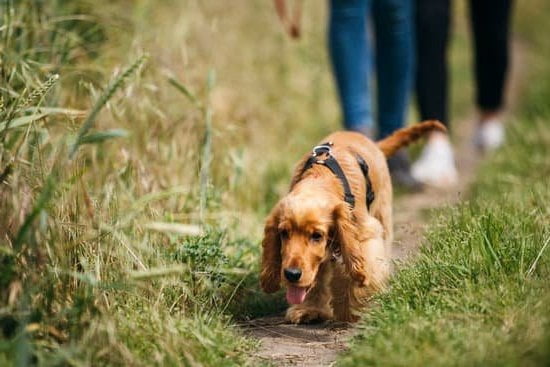Have you ever wondered how to train your dog to detect syncope? Syncope, commonly referred to as fainting, is a medical condition characterized by a temporary loss of consciousness due to a lack of blood flow to the brain. Understanding the symptoms of syncope is crucial for early detection and intervention. Symptoms may include dizziness, lightheadedness, confusion, and even a sudden loss of consciousness.
Syncope can be unpredictable and potentially dangerous, especially for individuals who experience it frequently. This is where service dogs trained to detect syncope play a vital role in providing assistance and alerting their owners or caregivers to an impending episode. By training your dog to recognize the signs of syncope, you can help mitigate the risks associated with this condition and improve overall quality of life.
In this article, we will delve into what syncope is, how service dogs are trained to detect it, the benefits of having a syncope detection dog, and practical steps on how you can train your own furry companion. With the right knowledge and guidance, you can empower your dog to potentially save lives through early detection of syncope episodes.
Stay tuned as we explore the world of syncope detection training for dogs and learn how these amazing animals can make a significant difference in people’s lives.
What Is Syncope
Syncope, commonly known as fainting or passing out, is a temporary loss of consciousness caused by a lack of oxygen reaching the brain. It can be triggered by various factors such as low blood pressure, dehydration, heart conditions, or even emotional stress. Understanding the symptoms of syncope is crucial in order to effectively train your dog to detect and respond to such episodes. Often, individuals experiencing syncope may exhibit dizziness, lightheadedness, blurred vision, weakness, nausea, and eventually lose consciousness.
Training your dog to detect syncope involves teaching them to recognize subtle changes in your behavior or scent that precede a fainting episode. Dogs have an incredible sense of smell and can be trained to pick up on specific scents associated with physiological changes during a syncope episode.
By learning how to train your dog to detect syncope, you are equipping them with the skills to potentially save your life or the life of someone you care about in a critical situation.
To start training your dog to detect syncope, it is important to choose the right breed that has a strong sense of smell and a predisposition for service work. Breeds such as Labrador Retrievers, German Shepherds, and Golden Retrievers are commonly used as service dogs due to their intelligence and trainability.
Once you have selected the appropriate dog for this training, you can follow a step-by-step guide that includes associating scents with positive reinforcement, practicing simulated syncope episodes at home, and gradually increasing the complexity of detection scenarios.
The Role of Service Dogs in Detecting Syncope
Service dogs play a crucial role in detecting medical conditions, including syncope. These specially trained dogs have the ability to sense changes in their handler’s body before an episode of syncope occurs. By alerting their owner or caregiver, these dogs can help prevent serious accidents and provide valuable assistance in managing this condition.
How Service Dogs Detect Syncope
Service dogs are able to detect syncope by picking up on subtle changes in their handler’s behavior and body language. They are trained to recognize specific signs that indicate an impending syncopal episode, such as changes in breathing patterns, heart rate, or body temperature. Some dogs are even trained to respond to certain scents that are released by the body before a syncope episode occurs.
Training Methods for Syncope Detection
Training a service dog to detect syncope involves a combination of obedience training and specialized scent training. Initially, the dog is taught basic commands such as sit, stay, and come when called.
Once these foundational skills are established, the dog is then trained to recognize and respond to the specific signs of syncope displayed by their handler. This may involve using scent samples taken from the individual during a syncope episode to familiarize the dog with the unique smell associated with this condition.
Benefits of Having a Syncope Detection Dog
Having a service dog trained to detect syncope can greatly improve the quality of life for individuals living with this condition. These dogs provide an added sense of security and peace of mind, knowing that they have a companion who can help them in times of need. Additionally, having a syncope detection dog can increase independence and confidence, allowing individuals to engage in daily activities without fear of experiencing a syncopal episode without assistance.
Benefits of Training Your Dog to Detect Syncope
Having a dog trained to detect syncope can provide numerous benefits for individuals with the condition. One of the main advantages is the potential to receive early warnings before an episode occurs, allowing the person to take preventive measures or seek assistance.
This early detection can be crucial in preventing injuries that may result from sudden fainting spells. Additionally, having a syncope detection dog can offer peace of mind to both the individual with syncope and their loved ones, knowing that there is an extra layer of protection in place.
Furthermore, training your dog to detect syncope can enhance independence and quality of life for individuals living with the condition. With a well-trained service dog by their side, people with syncope may feel more confident going about their daily activities, knowing that they have a reliable companion who is looking out for their well-being.
This increased sense of security and autonomy can lead to improved mental well-being and overall happiness for both the individual and their furry partner.
Moreover, having a dog trained to detect syncope can also improve emergency response times in case an episode does occur. By alerting others to the impending fainting spell, the trained service dog can help ensure that appropriate medical attention is provided promptly. This quick response can minimize risks and complications associated with syncope episodes, ultimately contributing to better outcomes for individuals living with the condition.
Choosing the Right Dog for Syncope Detection Training
When it comes to training a dog to detect syncope, choosing the right breed and individual dog is crucial for success. While any dog can potentially be trained for this task, certain breeds are known for their natural abilities and characteristics that make them well-suited for syncope detection training. Here are some factors to consider when selecting the right dog for this specialized training:
- Breeds with a strong sense of smell: Dogs with exceptional olfactory senses, such as Bloodhounds, German Shepherds, Labradors, and Belgian Malinois, are often preferred for detection work.
- Temperament: Dogs that are calm, focused, and have a strong desire to please their owners tend to excel in training programs. Breeds like Golden Retrievers and Dobermans are known for their obedience and eagerness to learn.
- Size and physical capabilities: Larger dogs may be better suited for assisting individuals who need physical support during syncopal episodes. However, smaller breeds like Dachshunds or Poodles can also be trained successfully depending on the specific needs of the handler.
Furthermore, it’s important to remember that each dog is unique, so evaluating an individual dog’s personality, energy level, and trainability is essential in determining their suitability for syncope detection training. Some dogs may show natural aptitude for detecting changes in their owner’s health or behavior, which can be a good indicator of their potential success in this type of training.
Additional Considerations
- Age: Younger dogs may have more energy and enthusiasm for training sessions but may require more time and patience to develop the necessary skills.
- Health: A dog in good physical health is better equipped to handle the rigorous training involved in syncope detection work. Regular veterinary check-ups can help ensure your dog’s well-being throughout the training process.
- Training experience: Dogs that have previous experience in obedience training or scent work may progress more quickly in syncope detection training due to their existing foundation of skills.
Step-by-Step Guide on Training Your Dog to Detect Syncope
Syncope, also known as fainting or passing out, can be a concerning condition that impacts many individuals. Training your dog to detect syncope can provide an added layer of safety and support for those who may experience this medical issue. With the right training and guidance, your furry companion can become a valuable ally in recognizing the signs of syncope and alerting you or others to take action.
To start training your dog to detect syncope, it is essential to understand the symptoms associated with this condition. Syncope often presents itself as sudden dizziness, lightheadedness, confusion, pale skin, sweating, and a rapid heartbeat. By familiarizing yourself with these indicators, you can begin teaching your dog how to recognize them through specialized training techniques.
Here is a step-by-step guide on how to train your dog to detect syncope effectively:
1. Establish Trust: Develop a strong bond with your dog based on trust and positive reinforcement techniques.
2. Introduce Scent Recognition: Familiarize your dog with the scent associated with syncope by using samples from individuals who experience fainting episodes.
3. Associate Scent with Rewards: Use treats or toys to reward your dog when they successfully identify the scent of syncope.
4. Practice Alerting Behavior: Teach your dog a specific behavior or signal to indicate when they have detected the scent of syncope.
5. Reinforce Training Regularly: Continuously practice and reinforce your dog’s ability to detect syncope through consistent training sessions.
By following these steps and remaining patient throughout the training process, you can empower your canine companion with the skills needed to detect syncope effectively. Remember that each dog learns at its own pace, so consistency and positive reinforcement are key elements in ensuring successful training outcomes.
Common Challenges in Training Dogs for Syncope Detection
Training your dog to detect syncope can be a rewarding experience, but it also comes with its own set of challenges. From distractions to maintaining focus, here are some common challenges that you may encounter during the training process.
Distractions
One of the main challenges in training your dog to detect syncope is dealing with distractions. Dogs have a natural curiosity and can easily be distracted by their surroundings. It is important to create a controlled environment during training sessions to minimize distractions and help your dog stay focused on learning the detection behavior.
Consistency
Consistency is key when it comes to training your dog to detect syncope. Dogs thrive on routine and repetition, so it is important to establish a consistent training schedule and stick to it. Inconsistency in training can lead to confusion for your dog and hinder their progress in learning how to detect syncope effectively.
Variable Response
Another challenge in training dogs for syncope detection is ensuring they provide a clear and consistent response when they detect an episode. Some dogs may become overly excited or anxious when they recognize the signs of syncope, while others may display hesitation or uncertainty. It is crucial to work on shaping the desired response through positive reinforcement techniques and continuous practice.
By understanding these common challenges and addressing them proactively, you can improve the effectiveness of your dog’s training for detecting syncope. With patience, consistency, and perseverance, you can overcome these obstacles and empower your furry companion to potentially save lives through their remarkable ability to detect syncope episodes.
Real-Life Success Stories of Dogs Detecting Syncope
It is truly remarkable how dogs can be trained to detect medical conditions such as syncope in humans. There have been numerous real-life success stories where dogs have accurately alerted their owners or caretakers to an impending syncope episode, allowing for timely intervention and potentially saving lives. These heartwarming tales showcase the incredible bond between humans and their canine companions, as well as the life-changing impact that a trained service dog can have on individuals living with syncope.
One such inspiring story involves a Labrador Retriever named Max, who was trained specifically to detect subtle changes in his owner’s body language and scent when a syncope episode was about to occur. Through diligent training and positive reinforcement techniques, Max learned to paw at his owner or fetch a designated object whenever he sensed an impending fainting spell.
Thanks to Max’s quick reactions, his owner has been able to receive prompt medical attention whenever a syncope episode occurs, significantly improving their quality of life and overall well-being.
Another touching example is the story of Luna, a Golden Retriever mix, who was adopted from a shelter and trained by her new owner to detect syncope episodes using scent cues. Luna’s remarkable ability to recognize the unique odors associated with her owner’s physiological changes has enabled her to alert them before they experience fainting spells.
This early warning system provided by Luna has not only enhanced her owner’s safety but also strengthened the bond between them through mutual trust and reliance.
| Real-Life Success Stories | Dogs Detecting Syncope |
|---|---|
| Max the Labrador Retriever | Trained to paw or fetch object when sensing an episode |
| Luna the Golden Retriever mix | Adopted from shelter and trained to recognize scents of physiological changes |
These heartwarming tales serve as powerful reminders of the incredible abilities of dogs when it comes to detecting health conditions like syncope. By investing time and effort into training your dog to recognize the signs of syncope, you could potentially transform their role from a beloved pet into a lifesaving guardian.
The bond formed through this training process not only benefits your own well-being but also showcases the innate compassion and intelligence of our canine companions in supporting us through various challenges in life.
Tips and Tricks for Maintaining Your Dog’s Training
Training your dog to detect syncope can be a rewarding and life-saving experience. However, it is essential to maintain their training regularly to ensure they remain proficient in detecting the signs of syncope. Here are some tips and tricks to help you keep your dog’s skills sharp:
Firstly, consistency is key when it comes to maintaining your dog’s training. Set aside regular time each day for practice sessions to reinforce their detection abilities. Consistent training will help your dog stay on top of their game and quickly recognize the subtle signs of syncope.
It is also important to vary the scenarios in which you conduct training sessions with your dog. Practice in different environments, around various people, and simulate different situations that may trigger a syncopal episode. By exposing your dog to a range of circumstances during training, you can ensure they are prepared to detect syncope wherever it may occur.
Furthermore, always provide positive reinforcement during training sessions. Reward your dog with treats, praise, or playtime when they successfully detect the signs of syncope. This positive feedback will motivate them to continue performing well and make the training experience enjoyable for both you and your furry companion.
By following these tips and tricks for maintaining your dog’s training in detecting syncope, you can empower them to potentially save lives with their remarkable abilities. Consistent practice, exposure to diverse scenarios, and positive reinforcement will help keep your dog sharp and ready to detect syncope whenever necessary.
Conclusion
Training your dog to detect syncope can be a life-saving skill that not only benefits individuals with medical conditions prone to fainting spells, but also enhances the bond between a handler and their furry companion. By following the step-by-step guide provided in this article, you can successfully train your dog to recognize the signs of an impending syncopal episode and alert you or others to take necessary precautions.
One of the key benefits of training your dog to detect syncope is the added layer of security it brings to your daily life. With their keen sense of smell and ability to pick up on subtle changes in behavior, dogs are able to provide an early warning system for potential syncopal episodes, allowing individuals to sit or lie down in a safe place before losing consciousness.
This proactive approach can prevent accidents and injuries associated with sudden fainting spells, ultimately improving the quality of life for those affected by syncope.
While there may be challenges along the way, such as distractions or difficulty with certain training techniques, perseverance and patience are vital in successfully teaching your dog how to detect syncope. By incorporating positive reinforcement, consistency, and regular practice into your training routine, you can help your canine companion master this important skill and potentially save lives in the process.
Remember, with dedication and guidance, you have the power to empower your dog as a valuable partner in managing syncope effectively.
Frequently Asked Questions
How Can Dogs Detect Syncope?
Dogs can detect syncope by picking up on changes in their owner’s body language, heart rate, and scent. They are attuned to subtle signs that indicate a potential fainting episode, allowing them to alert their owner beforehand.
How Do Dogs Know You’re Going to Faint?
Dogs are incredibly perceptive animals and can sense changes in their owner’s behavior and physiology that precede fainting. They may pick up on cues such as dizziness, disorientation, or a drop in blood pressure, giving them a heads-up before the actual fainting occurs.
How Do I Train My Dog to Be a Medical Alert?
Training a dog to be a medical alert involves teaching them to recognize specific physiological changes associated with medical conditions like syncope. This often involves using positive reinforcement techniques to reward the dog for alerting when they notice these changes, gradually reinforcing the behavior over time.
Consistent training and practice are key to success in training a dog for this important task.

Welcome to the blog! I am a professional dog trainer and have been working with dogs for many years. In this blog, I will be discussing various topics related to dog training, including tips, tricks, and advice. I hope you find this information helpful and informative. Thanks for reading!





